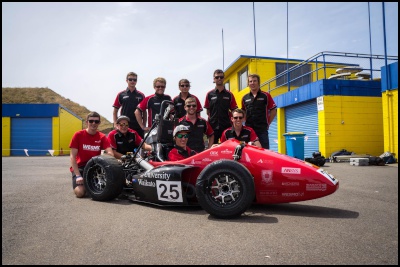‘Unknown’ speed sport debuting at CRC Speedshow
‘Unknown’ speed sport debuting at CRC
Speedshow
A virtually unknown motorsport in
New Zealand will be showcased for the first time at
CRC
Speedshow in Auckland this month.
An internationally competed for series, known as Formula SAE, will see both engineering students from Waikato and Auckland Universities work hard to outwit each other, and battle it out on the race track during the two-day event at the ASB Showgrounds, 16-17 July.

Formula SAE is an international student
engineering design competition organised by the Society of
Automotive Engineers (SAE International). It’s performed
on tight tracks demanding fast-accelerating,
agile cars
more suited to autocross courses rather than open circuit
racing.
The group holds competitive meets throughout the world – currently Waikato University’s team, which has only been participating for 10 years, is ranked 85th out of 528 teams representing competing university and technology institutes from around the world.
The Waikato team,
WESMO (Waikato Engineering Students Motorsport
Organisation), has only nine members, who are all in their
final year of an engineering honours degree. Many overseas
teams have 30
to 70 people, says Wesmo’s sponsorship
coordinator and suspension engineer, Nathan
Senior.
“Generally, New Zealanders haven’t encountered Formula SAE because it’s held outside of the country and is limited to university students who are studying engineering,” he says.
There are only three Kiwi
teams involved; Waikato’s WESMO and one each from Auckland
University and The University of Canterbury.
“Currently Formula SAE is a relatively unknown sport here. It’s only people who become directly involved who truly know about it. Kiwi teams are always complimented on the quality of our cars, and we’re competitive in the Australasian region which has about 30 cars,” he says.
Senior describes
this scene as basically students playing F1, and there’s
always a professional, competitive, yet good humoured
atmosphere at get-togethers. Students work next to each
other and learn about their rivals’ designs – it’s a
great learning environment.
“It would be awesome to see more of the New Zealand universities and polytechs get involved in Formula SAE to increase the Kiwi presence. It would be great to send Kiwi teams to other competitions in Europe and the USA.
“At CRC Speedshow we taking part in the Ultimate Speed Machine Challenge and running our 2015 model against the Auckland team, and other types of vehicles in the arena. We’ll also have a stand in pit lane and people are welcome to come by and talk with us,” says Senior.
His team is constantly looking for companies
to help represent them – both at home and
overseas.
“We’re really looking forward to
attending CRC Speedshow and being able to display our 2015
car. It’s going to be interesting to see how both of the
SAE cars perform - not only against each other - but also
against the different types of speed machines.”
The concept behind Formula SAE is that a fictional manufacturing company has contracted a student design team to develop a small Formula-style race car. The prototype car is to be evaluated for its potential as a production item.
The target marketing group for the race car is the non-professional autocross racer. Each student team designs, builds and tests a prototype based on a series of rules, the purpose being to ensure on-track safety (the cars are driven by the students themselves) and trigger problem solving.
The prototype car is judged in a number of
different events, both static and dynamic.
Static
events assess the overall design, manufacturing quality and
business logic, where teams are able to share their design
ideas and display excellence in the aspects such as
marketing and finance.
Dynamic events test a
vehicle’s track performance, acceleration, skid-pad and
autocross track handling, and endurance.
The competition regulations mean that teams have to work to strict restrictions. These include a 20mm air restrictor on the intake, E85 or 98RON fuel only, 1525mm minimum wheel base, combustion engine limited to 610cc maximum engine displacement, 232kg weight, and the ability to reach - 100km/h in four seconds.
Senior says the Waikato’s WESMO aims to produce a reliable and strongly competitive race car, while at the same time offering students an experience to develop valuable engineering skills that will help with their future careers.
ENDS


 Gordon Campbell: On bird flu, AUKUS entry fees and Cindy Lee
Gordon Campbell: On bird flu, AUKUS entry fees and Cindy Lee Peace Action Wellington: Die In for Palestine Marks ANZAC day
Peace Action Wellington: Die In for Palestine Marks ANZAC day Labour Party: Penny Drops – But What About Seymour And Peters?
Labour Party: Penny Drops – But What About Seymour And Peters? Government: PM Announces Changes To Portfolios
Government: PM Announces Changes To Portfolios Family First: Just 1 In 6 Oppose ‘Three Strikes’ - Poll
Family First: Just 1 In 6 Oppose ‘Three Strikes’ - Poll Labour Party: Budget Blunder Shows Nicola Willis Could Cut Recovery Funding
Labour Party: Budget Blunder Shows Nicola Willis Could Cut Recovery Funding  Government: Urgent Changes To System Through First RMA Amendment Bill
Government: Urgent Changes To System Through First RMA Amendment Bill


